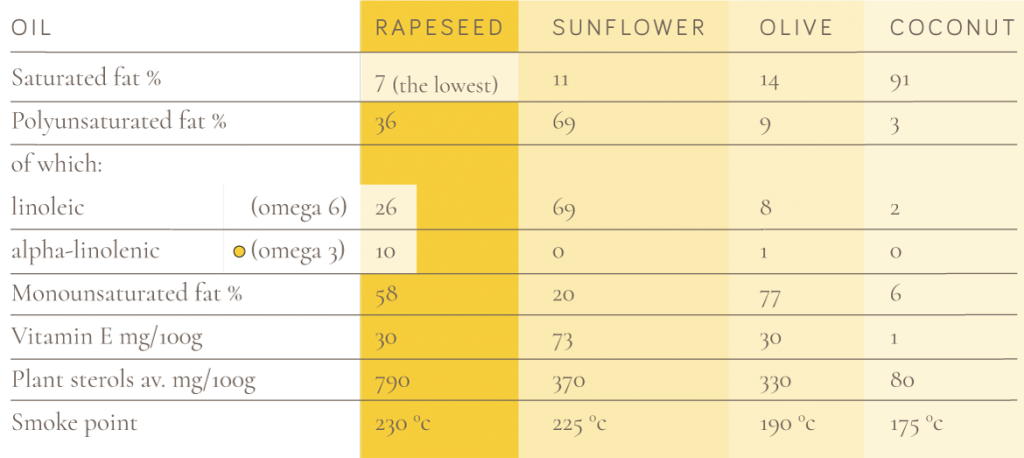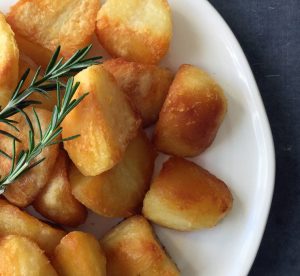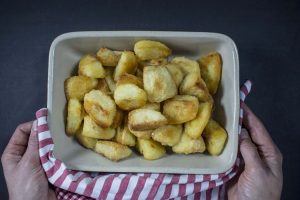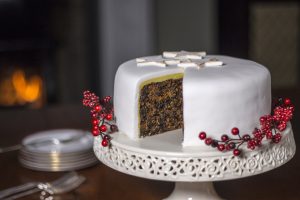Now that the weather is warming up, it is the perfect time to start making salad dressings with cold pressed rapeseed oil. With half the saturated fat of olive oil and ten times the Omega 3 of olive oil, cold pressed rapeseed oil is a fantastic choice for creating healthy salad dressings. Not only healthier, Mellow Yellow Cold Pressed Rapeseed Oil has a very subtle nutty flavour with buttery undertones, a fantastic flavour profile for creating delicious salad dressings. As we grow, press and bottle our rapeseed oil on our farm in Northamptonshire to LEAF Marque standards, you can rest assured that you are using a high quality, environmentally responsible British product.
Now that we know how great the oil is, here are some recipes for salad dressings with cold pressed rapeseed oil…
Blackberry Vinegar Dressing
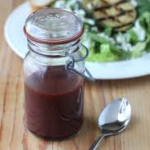
Ingredients:
1tsp Dijon mustard
1tbsp blackberry vinegar (we like Scrubby Oak or you can make your own with our simple recipe below)
3tbsp Farrington’s Mellow Yellow Rapeseed Oil
Method:
Mix the blackberry vinegar and dijon mustard in a screw top jar, then put the lid on and shake well. Add the Mellow Yellow (put the lid on again!) and shake vigorously again to get it all thoroughly blended. Adjust seasoning to taste. Store in the fridge and enjoy.
For the Blackberry Vinegar, steep blackberries with an equal quantity of cider vinegar for 5-10 days. After this time, strain the liquid and boil for 8-10 minutes with 450g of sugar per 700ml of liquid.
Sweet Oriental Dressing
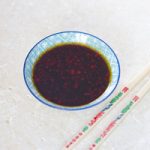
Ingredients:
1tbsp runny honey
½ chopped red chilli
1 tbsp dark soy sauce
1 tbsp Mellow Yellow Rapeseed Oil
Method:
Combine the runny honey, chopped chilli, dark soy sauce and Mellow Yellow Rapeseed Oil. Stir vigorously until combined.
Did you know that we make our own range of salad dressings?
– Honey & Mustard Dressing – Superbly balanced sweetness with a fantastic bite. Use on anything from a salad to a sausage. Try Honey & Mustard on our Asparagus, Salmon and Avocado Bruschetta as a tasty lunch or light dinner, the salmon and avocado perfectly complement the sweet and sharp flavour from honey and mustard.
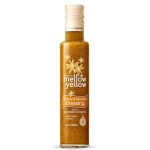
– Classic Vinaigrette – The ultimate salad dressing with a sharp tangy taste, perfect for a green salad. Try Classic Vinaigrette in this recipe for a Protein Power Pot with quinoa, watercress, egg and tuna for a filling lunch recipe ideal for taking to work.
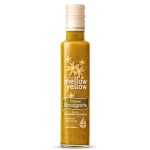
– Balsamic Dressing – A modern British twist on the classic Italian dressing, made with Aspall’s Apple Balsamic Vinegar for a deliciously fruity flavour. This dressing is perfect with Tomato, Basil and Mozzarella to highlight the delicious Italian flavour of the balsamic.
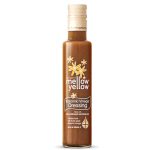
Find more salad recipes on the Recipe section of our website.
Duncan Farrington takes a closer look at what are fats, the different types of fats and clears up some of the confusion surrounding them:
We often hear contradicting messages about what we should and should not eat in our diets, we are told some foods are ‘good’ and others are definitely ‘bad’. It is confusing and frustrating sometimes not knowing what to do for the best. I really believe in keeping things simple when it comes to eating a healthy diet, plus being honest with myself in the choices I make. For example, I personally enjoy spending an evening with friends over a couple of beers, but if I was to do this every evening of the week, over time it would lead to unhealthy consequences. The choice is mine.
What are fats?
In our diet, we need the right balance of macro and micro nutrients. Macro nutrients are the main food groups of carbohydrate, protein and fat. If we eat a balance of the three macro nutrients, preferably in as broader range of different foods as possible and ideally in a non-processed diet, we will also get all the micro nutrients of minerals and vitamins needed in our diet too.
As a very simple rule of thumb, a healthy diet consists of plenty of fruit and vegetables, plus around a third of our daily food intake coming from each of the main food groups – carbohydrate, protein and fat.
![]() Carbohydrates are found in foods such as cereals and rice, bread, potatoes, pasta, sugar.
Carbohydrates are found in foods such as cereals and rice, bread, potatoes, pasta, sugar.
![]() Proteins are found in meats, fish, pulses.
Proteins are found in meats, fish, pulses.
![]() Fats are found in cooking oils, fats and nuts.
Fats are found in cooking oils, fats and nuts.
It can become more confusing when we consider that most foods contain a mixture of the different food groups. For example, milk and dairy foods contain carbohydrates, proteins and fats as well as important vitamins and minerals. Fruits are a great source of minerals and fibre, but also contain carbohydrates (sugars). Eggs have both protein and fat. However foods such as biscuits and cakes are equally high in fat and sugar.
Fat is a crucial part of our diet, it is the most efficient source of energy, it helps our bodies absorb fat soluble vitamins, such as vitamins A,D,E and K. Fats play crucial roles within our bodies from cell membrane formation, to the development of our brain and even communication between different cells. They also insulate organs and contribute towards maintaining body temperature.
Like other food groups, fats are also complex, they are formed from fatty acids and can be split into three main types; Saturated, Poly-unsaturated and Mono-unsaturated. These terms are simply a description of the molecular make up of the particular fatty acid in ratio of the carbon to hydrogen atoms and how they are bonded together. Don’t worry about the chemistry – I struggle with it myself. However, just as we need a balance of macro nutrients in our diets, we also need a balance of the different fats, with around an equal split between saturated, poly-unsaturated and mono-unsaturated fats being a simple rule of thumb.
The much-heralded Mediterranean diet is shown as an example of healthy eating, where the population had much lower cases of heart disease compared with northern European populations. The Mediterranean diet is low in saturated fat, mainly comprising of olive oil, oily fish which contains poly-unsaturated fats and plenty of fruit and vegetables. This compared with a traditional northern European diet which is high in saturated fat, mainly from animal fats and not enough fruit and vegetables. It is important to recognise that the total fat consumed in the two diets was similar, it was just that one was in the right balance, where the other was not.
An easy way to recognise a saturated fat is that it is solid at room temperature, only becoming liquid once it is heated. Over the years, successful health messages have resulted in greater awareness of the need to reduce our saturated fat intake in Britain, which has been largely successful. We now eat less fatty meat and more sources of plant-based fats.
Oily fish is an important part of the Mediterranean diet because it is a good source of poly-unsaturated fatty acids. Poly-unsaturated fatty acids play vital roles in the reduction of cholesterol in our bodies as well as being crucial for healthy brain and eye development. They are often called essential fatty acids, as the body can only get them in the diet and can not make them internally. These fats can also be found in certain nuts and seeds such as rapeseed, sunflower seed or peanuts. As nutritionists became aware of the need and role of poly-unsaturated fats in the diet following World War II, food companies developed non-dairy spreads to replace butter which has a higher saturated fat content with ‘healthier’ alternatives such as sunflower or corn oil, these have less saturated fat and higher poly-unsaturated fats. However, over the years, knowledge and learning about these complex fatty acids increased, to discover that poly-unsaturated fats are also made up of different types which can be broadly categorised in to Omega 3 and Omega 6. Not only did scientists discover the different types of poly-unsaturated fats, they also discovered that bodies need to consume these in an ideal balance of around two parts of Omega 6 for every one part of Omega 3.
With this new-found knowledge, it was also realised that the oils traditionally used to make non-dairy spread, were good sources of Omega 6, but had little or no Omega 3. Additionally, people who eat a high proportion of processed foods, much of it using sunflower, corn or palm oils for example, were in fact eating an unhealthy ratio of Omega 6 to Omega 3 of up to 20 times to 1, compared to the ideal of 2 to 1, causing other bad health issues in our diet. Some responsible food manufacturers have recognised this problem and have replaced such unbalanced fats with better options. A good example is a leading brand of non-dairy spread which used to be made with sunflower oil, which had the strap line in advertising campaigns in the 1980’s about it being ‘high in poly-unsaturates’, even though sunflower oil has no omega 3. The recipe was completely changed to replace sunflower oil with rapeseed oil, which has the perfect balance of poly-unsaturated fats in a ratio of 2.6g of Omega 6 for every 1g of Omega 3.
The final type of fat we need in our diet is mono-unsaturated. Mono-unsaturated fats are found in plant foods such as nuts and seeds, with olive oil and rapeseed oil being rich sources of these fats, as well as avocados for example.
For more information on what are fats and the role of fats in our diet, look at https://www.farrington-oils.co.uk/interesting-oil/ which also includes three excellent articles form the British Nutrition Foundation.
As I said at the start, information and advice can be confusing and frustrating, but for my part I stick to my own rules of:
![]() Eat a well-balanced diet, around a third each of carbohydrate, protein and fat
Eat a well-balanced diet, around a third each of carbohydrate, protein and fat
![]() The broader the diet of different foods and meals I enjoy, the better
The broader the diet of different foods and meals I enjoy, the better
![]() Eat a well-balanced diet of the different fats
Eat a well-balanced diet of the different fats
![]() ‘Good’ and ‘Bad’ foods don’t really exist, it is just the quantity of each that makes a difference
‘Good’ and ‘Bad’ foods don’t really exist, it is just the quantity of each that makes a difference
![]() Be honest with yourself – I know what treats to enjoy sparingly and what I should eat more of. More cabbage, less biscuits!
Be honest with yourself – I know what treats to enjoy sparingly and what I should eat more of. More cabbage, less biscuits!
For more information, The British Nutrition Foundation has written independent articles for us on The Importance of Fats, Introduction to Healthy Fats and A Comparison of Different Culinary Oils.
We all know that food waste is a growing problem. In 2016, British shoppers threw away a shocking 160 million bananas! Alhough they may be the countries favourite fruit to snack on, they are also the most wasted. Unfortunately, 1 in 3 people will throw away a banana if it has a bruise or even a single black mark on its skin. It really is bananas!
Here at Farrington’s, we think that one of the best ways to cut down food waste is to shout about all the amazing recipes that you can use these ingredients in, rather than throwing them away. So, here are our Top 5 Leftover Banana Recipes…
If you’re not ready to make any of these recipes straight away, just peel and slice your bananas, and then freeze them in a Tupperware box or freezer bag. Once in slices, the frozen bananas are perfect for smoothies or any of our other recipes. You’ll have banana ready to go in your freezer for whenever you fancy making one of these recipes!
Banana Bread – The original way to use up bananas. Banana bread is a regular in the Mellow Yellow kitchen as it is such a simple cake to bake and gives truly delicious results! We have two well loved recipes, click here for our traditional recipe and here for our vegan alternative!
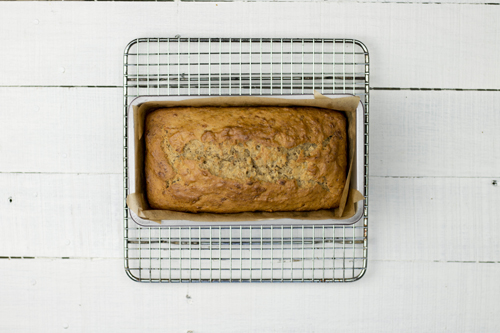
Banana Ice-Cream – Freeze bananas as they go past the point you would like to eat them. Cut the frozen bananas into a food processor and add 1 generous tablespoon of vanilla yogurt (or any other type of dairy like quark, double cream, forage frais) per banana. Blitz until smooth. Each banana creates two scoops of ice cream. Serve immediately. (Preferably with warm brownies.)
Vegan Pancakes – If you want to try vegan pancakes, ripe bananas are perfect. Simply mash 1 banana and whisk together with 150ml coconut milk (or any other milk alternative you like), 100g plain flour and ½ tsp baking powder. This mixture is meant to be pourable so if it’s too thick just add a splash more milk, or if too runny add another spoonful of flour. Heat up some Mellow Yellow Rapeseed Oil in a frying pan and dollop large tablespoons of your mixture in to cook. Cook each pancake for 2-3 minutes, flipping when bubbles begin to appear on top, then cook for a further 2 minutes. Serve your pancakes in a big stack with your choice of sauce drizzled over.
Carrot and Banana Cake – Our oldest and most loved cake recipe. So easy, delicious and freezes well – a total favourite. The carrot and banana cake is a great afternoon tea sweet choice and a fantastic way to cut down on your food waste by using bananas rather than throwing them away. Find the recipe here.
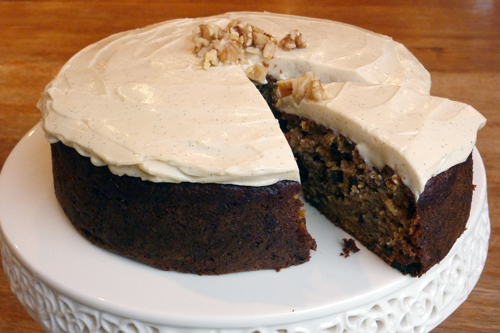
Smoothies – Overripe or frozen bananas are perfect for smoothies! Simply add them to your blender with any other fruit, milk or yogurt you have and after a a quick blitz, you’ll have a delicious and filling breakfast smoothie!
What do you use your leftover bananas for? Share your recipes with us on Facebook, Twitter or Instagram!
Did you know that cold pressed rapeseed oil is a great, heart-happy oil? Are you looking to improve your health? Well we have one simple change for you that will help you with this goal. Mellow Yellow Cold Pressed Rapeseed Oil is a brilliantly healthy, British cooking oil that is grown, pressed and bottled in Northamptonshire. Read on to find out more about all the fantastic health benefits of cold pressed rapeseed oil…
Top 4 Health Benefits of Cold Pressed Rapeseed Oil
Low saturated fat
A balance of Omega 3 and Omega 6
Contains Vitamin E
Naturally occurring plant sterols
Low saturated fat
Saturated fat is usually found in high levels in fatty meats, full fat dairy products, coconut oil and lard. For many years, health professionals have advised against consuming high amounts of saturated fat as they have been shown to raise your LDL (Low Density Lipoprotein) levels. LDL is known as ‘bad’ cholesterol as high levels of LDL blood cholesterol increases the risk of heart disease by building up in our arteries and causing them to narrow. Cold pressed rapeseed oil, however, has very low levels of saturated fat. This is one of the major health benefits of cold pressed rapeseed oil! For more information from the British Heart Foundation, click here.
A balance of Omega 3 & Omega 6
Mellow Yellow Cold Pressed Rapeseed Oil contains both Omega 3 and Omega 6. These are essential fatty acids that the body is unable to produce itself so we need to ensure that we consume these in our diet. These two essential fatty acids contribute to brain development, growth and maintaining a healthy immune system. It is important that we consume these two fatty acids in the correct ratio as found in cold pressed rapeseed oil. It is this ratio that makes this one of our top health benefits of cold pressed rapeseed oil. We have more information on Omega 3 and 6 on our Health and Nutrition page.
Contains Vitamin E
Another of the health benefits of cold pressed rapeseed oil is that it contains vitamin E. Vitamin E occurs naturally in cold pressed rapeseed oil and is needed for a strong immune system and healthy eyes and skin.
Naturally occurring plant sterols
Last but not least in our top health benefits of cold pressed rapeseed oil are the naturally occurring plant sterols found in this brilliant oil. Plant sterols are fat-soluble compounds found in some vegetables, nuts and seeds, including rapeseed. They are similar in structure to cholesterol therefore when eaten, plant sterols compete with cholesterol for absorption into the bloodstream. Our bodies find it easier to absorb plant sterols as they block the cholesterol from being absorbed. This results in the cholesterol passing through and out of the body via the stool. Find more information here.
Comparison of oils:
With these brilliant health benefits of cold pressed rapeseed oil, it’s easy to see why so many people are swapping to Mellow Yellow Rapeseed Oil! Find out where to buy here.
If you want to know more about cold pressed rapeseed oil, how we produce it, how it grows, the simple way we press the seeds to produce our cold pressed rapeseed oil and more on what is so special about cold pressed rapeseed oil, have a look at this article!
For recipe inspiration on what to cook with cold pressed rapeseed oil, visit our Recipe page here.
Christmas is just around the corner so now is the perfect time to share with you some of our favourite recipes, hints and tips for festive cooking! The Mellow Yellow team has all contributed a recipe or a favourite tip to help you ensure this is the best Christmas yet.
Tips For Roasties…
Roast potatoes – Make sure you use Farrington’s Mellow Yellow Rapeseed Oil. Thanks to its high smoke point, it helps you achieve extra crispy roast potatoes as it performs brilliantly at high temperatures. Take a look at Joanna’s freezer tip below if you want to save time on your roasties.
To save time on the big day, parboil and freeze your potatoes a few days earlier. Then once your meat is out of the oven, heat up Farrington’s Mellow Yellow Rapeseed Oil in a roasting dish until nice and hot, then put in your parboiled potatoes from frozen. This will make EVEN crispier roast potatoes, and save you a bit of space on the hob. (As heard by Joanna on Radio 2.)
Mince Pies
Mince Pies – Homemade mince pies really are so much better than shop bought ones, plus our recipe has a secret addition of chopped apple in the mincemeat that elevates the flavour!
A different way to eat a mince pie – Heat it up and take the lid off, pop a slice of stilton inside while it’s still hot then put the lid back on. Enjoy your sweet and savoury treat! (Rachel promises us this is delicious.)
Any other tips?
Use roasting bags for a juicy turkey and start with a clean oven to make the clean up easier! If you’re not feeding the five thousand, buy a turkey crown as it’s solid meat, takes less time and fits in a roasting bag perfectly! (Jo’s top tips for a stress-free Christmas!)
Leftover Christmas Cake? Don’t waste it, instead cut into large chunks, cover with clingfilm then foil, and freeze. (Gina’s favourite way to keep Christmas going until Spring)
Chestnut Stuffing – Emily’s Christmas dinner highlight
Ingredients:
100g bacon
50ml Mellow Yellow Rapeseed Oil, plus extra for greasing tin
1 onion peeled and chopped finely
150g sliced mushrooms
250g chestnut puree
250g tin whole chestnuts ground like breadcrumbs
Small tin or tube of liver pate
3 large cloves of garlic chopped finely
1 tablespoon (15ml) dried oregano
50g fresh breadcrumbs
1 lightly whisked egg
Salt and black pepper to taste
Method:
Cut any rind off the bacon and chop into small cubes. Put Mellow Yellow Rapeseed Oil into pan and fry bacon and onion for about 3-5 minutes. Transfer to a bowl with all the fat and stir in well with all the other ingredients and check seasoning. Grease baking tin with Mellow Yellow oil and cook in a preheated oven at 180c for 45 minutes.
Boozy Cranberry sauce – Richard’s way to add a kick to lunch time
This is one to start this year ready for next Christmas as it needs 10-12 months to infuse. But its a great thing to start during any time off you have this Christmas!
Firstly make cranberry Gin as you would sloe gin:
Ingredients:
450g/1lb Cranberries, frozen will work
225g/8oz caster sugar
1 litre/1¾ pint gin
Method:
Prick the skin of the cranberries all over with a clean needle and put in a large sterilised jar. Pour in the sugar and the gin, seal tightly and shake well. Store in a cool, dark cupboard and shake every other day for a week. Then shake once a week for at least two months. After 10-12 months strain the cranberry gin through muslin into a sterilised bottle . Once you have strained the gin, cook the soaked cranberries down to a jam like consistency adding a little salt and or sugar to taste. And there you go, delicious homemade boozy cranberry sauce, plus cranberry gin for a festive G&T!
Find more recipes here.
As the UK’s first seed to bottle producer of rapeseed oil, our British heritage is incredibly important to us! From 24th September to 8th October, the UK has been celebrating British Food Fortnight with the hashtag #BritishFoodFortnight. To show our passion for British food, we’ve been sharing our favourite recipes on Twitter each day. In case you missed these recipes, we’ve collated them all here for you. So take a look through and let us know which ones you’ll be trying next.
No self-respecting roast dinner would ever be seen without these by its side. Using our British cold pressed rapeseed oil on your Sunday roasties ensures you the crispiest potatoes. Thanks to the high smoke point of the oil, your potatoes can get nice and hot, helping them get that crispy coating.
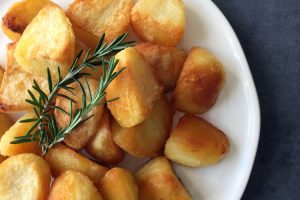
A quintessentially British fruit, the humble plum sings in this Plum Cake recipe. With ground almonds to add a nutty flavour, this cake is fantastic for a Sunday afternoon tea, or even just to whip up mid-week for a surprise guest!

Using British beef, this recipe will always go down well when brought to the table. Simple, perfectly seasoned and deliciously succulent, it truly is a classic dish. We love our steak served with potato wedges and garlic mushrooms, but there are so many other options you could choose from.
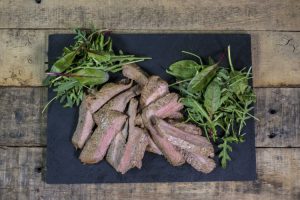
Almond and rhubarb make perfect partners in our Rhubarb Cake, which is an easy yet impressive bake. This is a fantastic way to use any seasonal rhubarb you have, as well as impressing your family with a delicious treat for them to tuck into!

One Pot Honey & Mustard Parsnip Chicken
This recipe uses our Honey & Mustard dressing as a delicious cooking sauce. Simply pour the sauce over your chicken thighs and British parsnips, pop it in the oven and there you go, a tasty one pot dish that’s perfect to warm you up during the colder weather that British Food Fortnight signals.
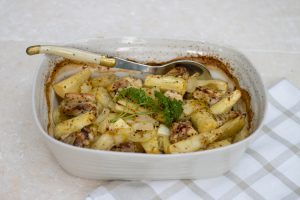
Usually eaten at Easter time, British lamb can also be sourced later on in the year with a stronger, more developed flavour. Our recipe for Roast Lamb uses garlic, rosemary, lemon and plenty of seasoning to bring out the most flavour possible from your lamb.
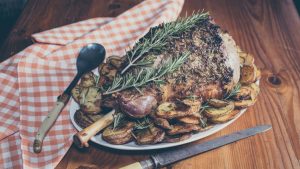
A true British favourite, we couldn’t talk about British Food Fortnight without including these. In our opinion, no matter what meat you’re having, no Sunday roast is complete without a Yorkshire pudding brimming with gravy. Get your oil nice and hot, ours has a high smoke point which really helps, to get those puddings rising nice and high!

Blueberry & White Chocolate Muffins
The delicate flavour of Mellow Yellow lends itself perfectly to cake baking and is particularly good in these marvellous muffins. Blueberry and White Chocolate Muffins fresh from the oven will attract the entire household, so make sure to grab one for yourself before everyone else descends!
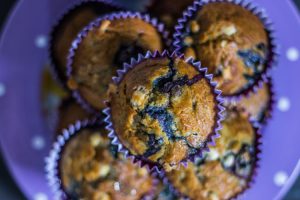
Such a simple side to make, and goes with so many different things. We like using British rooster potatoes in our Potato Wedges, but you can use any type of potato. A drizzling of Mellow Yellow and a good pinch of salt is all you need to create the most delicious wedges to be enjoyed by the whole family.
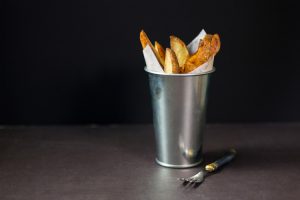
A beautifully light and fluffy lemon cake with a zesty lemon drizzle icing. Quick and easy for an everyday treat for the family but makes an impressive afternoon tea centerpiece if you’re planning a party.

Fresh Asparagus and Mellow Yellow Mayonnaise
British asparagus has to be one of our highlights of June, especially when combined with our delicious Mellow Yellow Mayonnaise. Our favourite way to serve this is by BBQ’ing the asparagus then serving it in a big pile with plenty of mayo ready for dipping!

This recipe produces a really easy, moist fruity apple cake. A perfect way to use up any seasonal British apples (cookers or eating apples) whichever you have in the garden or the fruit bowl. Served with creme fraiche, or even ice cream if the weather is warm enough, this cake is sure to be a hit!
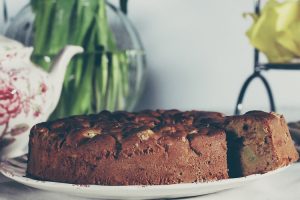
A wonderfully unusual way to use courgettes when in season. This fluffy courgette cake with its delicious lime cream cheese filling is a coffee morning or afternoon tea show stopper!

Pastry no longer needs butter! Using our incredibly simple recipe, you can make a quick and delicious pastry with Farrington’s Mellow Yellow Rapeseed Oil. This recipe is for a fruity Blackberry and Apple Galette, perfect with a hearty pouring of custard or double cream.

British Food Fortnight has been a great way for us to shout about all the amazing food produced in Britain, but just remember to keep buying British! Tweet us and let us know which recipe is your favourite!
We are over the moon to have won not one, not two, not even three, but SIX stars at the 2017 Great Taste Awards for our Farrington’s Mellow Yellow products this year. The judges have awarded a 1 star Great Taste award to each of our Classic Vinaigrette, Honey & Mustard Dressing, Balsamic Vinegar Dressing, Chilli Oil, Mayonnaise and Garlic Mayonnaise. For most products, this is their second, or even third Great Taste award but for our Chilli Oil, this is the first time it has been awarded a Great Taste star and we couldn’t be happier!
The Great Taste awards are the world’s largest and most trusted food and drink awards, with a panel of over 500 experts judging each product, being described as the ‘Oscars of the food world’. This year, 12,366 food and drink products entered into these prestigious awards, with only the very best products being awarded the coveted stars.
Here’s what the judges had to say about our products:
Chilli Oil: A wonderful colour and clarity. The nuttiness of the oil is retained and a subtle hint of chilli makes a wonderful condiment for cooking.
Balsamic Dressing: Lovely fruity sweetness that lifted the palette.
Classic Vinaigrette: Herbs add to the complexity of flour with all the ingredients working in harmony.
Honey & Mustard Dressing: The honey flavour balances well with the mustard. Love the ‘pop’ of the mustard seeds too.
Mayonnaise: A very good colour, and the rapeseed oil really works well here. It’s light and creamy textured, and well seasoned with a light hand.
Garlic Mayonnaise: Good clean creamy mayo with a well-judged hint of garlic. Lovely richness and mouthfeel.
We’re so proud of all our brilliant products, so if you haven’t tried them all, head over to our Where to Buy page and find your local stockist!
Do you love finding new local food producers, farm shops, restaurants and pubs? Well we do too, so we’re proud to now be part of Great Food Club. Great Food Club is an independent website that selects and recommends local food and drink independents. Based purely on merit, Great Food Club checks all its members before allowing them to be listed on the site. They use the simple criteria of ‘would we recommend this to our foodie friends?’ The great news is, they would happily recommend us!
One of our favourite things about the Great Food Club it’s perfect for finding great food in your local area. We’re incredibly proud of the fact that we are a Northamptonshire producer and so this guide is great for other Northamptonians to hear about us. By simply entering your post code, you can discover a world of fantastic foodie finds, right on your doorstep!
It is free to join the Great Food Club. Simply head over to www.greatfoodclub.co.uk and sign up. It is a fantastic way for foodies to find local producers, restaurants and shops in their local area. They will send you a membership card, which you can use in certain establishments to claim a discount.
You can find us on Great Food Club at http://www.greatfoodclub.co.uk/business/farringtons-oils/. If you love our products, which we hope you do, please feel free to leave a review and let everyone know!
Weight gain and obesity are a twenty-first-century health issue. With all of this temptation surrounding us, it’s easy to go up a dress size without even noticing it. However, by adopting these simple healthier lifestyle steps shared with us from the British Nutrition Foundation into your daily regime, alongside a careful exercise programme, you can drastically reduce the extra weight you’ve been carrying.
How can I maintain a healthy body weight?
Being overweight increases the risk of chronic diseases such as heart disease, type 2 diabetes and some cancers. In order to maintain a healthy body weight, it is necessary to consume roughly the same amount of energy (calories) as your body uses for normal bodily functions and physical activity. Reducing fat intake can often help cut back on calories but it is also important to reduce your amount of ‘free sugars.’ ‘Free sugars’ are added to foods by manufacturers, cooks and consumers (such as table sugar) as well as sugars naturally present in honey, syrups and fruit juice. It’s worth noting that sugars found in fruits and vegetables and in milk and milk products such as plain yoghurt and cheese are not classed as free sugars. Foods that are often high in fat and/or free sugars include cakes, biscuits, pastries, desserts, deep fried foods, crisps, butter, cream, chocolate, sweets, some cheeses and oils/spreads, so try to eat these foods less often.
Remember the following when selecting and preparing food to help reduce your daily calorie intake and aim to consume a healthy, balanced diet:
- Base meals on starchy foods, whole grain and high fibre versions where possible, such as wholemeal bread, wholemeal pasta, brown rice and potatoes with skins and plenty of fruits and vegetables
- Remove visible fat from meat, skin from poultry, buy lean cuts wherever possible and try replacing some meat in your diet with pulses
- Grill, bake, poach or steam foods instead of frying or roasting them
- Choose low-fat, unsweetened dairy products (e.g. skimmed or semi-skimmed milk, reduced-fat cheese and low-fat plain yoghurt)
- Use reduced fat spreads where possible and opt for those high in unsaturated fats, see our article Make Sure You Eat the Good Fats for more information on this
- Choose tomato-based rather than creamy sauces
- Cook from scratch wherever possible
- Opt for low-calorie drinks such as unsweetened tea and coffee or plain water rather than sugars-sweetened options
- Limit fruit juice to 150ml per day. Try diluting it with water to make it go further.
- If you are hungry between meals, snack on fresh fruit and vegetables rather than foods high in fat and/or free sugar
- Eat more fibre – adults should be aiming to consume 30 g fibre per day to reduce the risk of chronic diseases such as heart disease, type 2 diabetes and colon cancer. Fibre-rich foods include wholegrain foods, potatoes with skins, fruit and vegetables, pulses, nuts and seeds.
Although sugars have been stealing a lot of media coverage recently, it is still important to think about the amount and type of fats in your diet in relation to weight gain and health.
The following article by the British Nutrition Foundation explains why Mellow Yellow is a great source of the ideal type of fat we should be including in our diet.
What is fat?
Fat is a macronutrient (like protein and carbohydrate) and is made up of fatty acids. Fatty acids can be classified as saturated or unsaturated depending on their chemical structure. Unsaturated fatty acids include monounsaturated fatty acids and polyunsaturated fatty acids. All fats provide 9 calories (kcal) per gram, which is more than double the number of calories provided by each gram of protein and carbohydrate that we eat (4 kcal per gram each). A high fat diet can, therefore, lead to weight gain over time.
Why do we need it?
Fat is a good source of energy and we need some of it in our diets to help our bodies to absorb the fat-soluble vitamins A, D, E and K. Within the body, fatty acids form an integral part of our cell membranes, helping to insulate and protect our internal organs, maintaining our body temperature and is involved in lots of body processes such as the development of our brains and the communications which occur between different cells. Cholesterol is needed to produce bile acids, which help us to digest food, and also some of our hormones.
We are able to synthesise most of the specific fatty acids we need apart from two polyunsaturated fatty acids – alpha linolenic acid (an omega 3 polyunsaturated fatty acid) and linoleic acid (an omega 6 polyunsaturated fatty acid). Your body needs these for brain development, growth and for a healthy immune system. They are described as ‘essential fatty acids’ as we need to obtain small amounts from our diet. Alpha-linolenic acid is found in rapeseed, walnut and soya oils and spreads made from these. Linoleic acid is also found in plant-based oils such as sunflower, corn, peanut, rapeseed, olive, safflower, sesame, walnut and soya oil and spreads made from these. Both of the essential fatty acids are present in smaller amounts in foods such as meat, eggs and oily fish.
How much fat should we be eating?
UK dietary guidelines recommend that adults consume no more than 35% of the energy from their foods from fat. This equates to roughly 90g of fat per day for men and 70g for women. Our fat intake in the UK has been falling since the 1960s and, on average, we are now eating around these amounts. While low-fat diets were promoted in previous years, diets containing a moderate amount of fat can be easier to adhere to. So while it is important to try to cut down your total fat consumption, if you are struggling to do this, focus on choosing healthier types of fat.
Saturated fat intake should be restricted to no more than 11% of food energy, which equates to roughly 30g for men and 20g for women, per day. This is because a high intake of saturated fat has been linked to high blood cholesterol, which is a well-known risk factor for heart disease. Aim to replace saturated fat in your diet with small amounts of unsaturated fats by opting for foods rich in unsaturated fats or complex carbohydrates such as wholegrain foods.

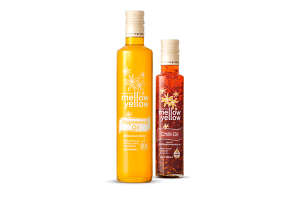 Oils
Oils Rapeseed Oil
Rapeseed Oil Chili Oil
Chili Oil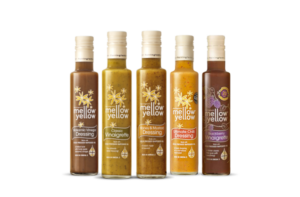 Dressings
Dressings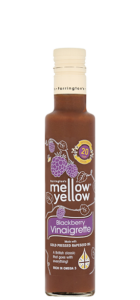 Blackberry Vinaigrette
Blackberry Vinaigrette Classic Vinaigrette
Classic Vinaigrette Balsamic Dressing
Balsamic Dressing Honey & Mustard
Honey & Mustard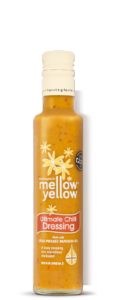 Ultimate Chilli Dressing
Ultimate Chilli Dressing